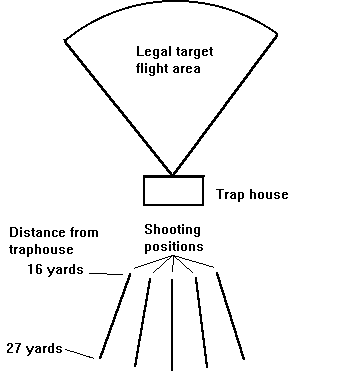Other clay target sports
- Skeet
- Sporting Clays
- International Trap
![]()
Trapshooting Overview
The type of trapshooting described here is known as American or Down-the-Line trap. It is the oldest and most basic, of all the Trap disciplines. American trap is shot over one trap machine which has a fixed elevation but constantly changing angles. The clay target is thrown away from the shooter and must travel between 50 and 55 yards. The height of the target is adjusted so that at a distance of 10 yards from the trap it’s height will be between 8 and 10 feet . The angles at which the target is thrown (to the left and right of the shooter), is constantly changing and should appear random and unpredictable. The maximum target angle is normally 22 degrees either side of center, but can be a maximum of 47 degrees.
A round of trap consists of 25 shots, with groups of five shots being taken from five shooting positions. There is a maximum of five people shooting per round which is called a squad. Each shooter on the squad shoots five shots from each of the five shooting positions. The shooters take turns shooting such that the first shooter will shoot one shot, then the second shooter takes their shot, etc. until all five shooters have shot 5 shots from a given shooting position. The shooters then rotate to the next shooting position and repeat the process.

In American trap there are three separate types of events that are shot, singles (a.k.a. 16-yard), handicap and doubles.
Singles
Singles are shot 16 yards behind the trap house, which why it is also known as the 16-yard event. Each shooter shoots five shots from each of the 5 shooting positions, with each shooter in order shooting at one target until all have shot five times, and then rotating in a clockwise manner to the next station.
Handicap
Handicap was designed so that shooters of different abilities could compete against each other fairly. In handicap the shooters stand farther away, between 17 and 27 yards, from the trap house. The greater a shooters ability the further back they stand. A shooter’s ability and hence the distance behind the traphouse from which they shoot (called their yardage), is determined by their average handicap score for the year and whether they have placed in the top 1-5 scores at any competition during the year. There are tree ways for a shooter to “earn” additional yardage, there by moving them back further from the traphouse. If a shooter wins a competition or places near the top, they can earn an additional half to 2.5 yards to their existing handicap yardage, if they shoot 96 or better out of a 100 targets, they can gain a half to 1.5 yards, or if their annual average is above 94, they can earn additional yardage.
Doubles
Doubles are shot from 16 yard line (16 yards from the trap house). In Doubles two targets are thrown at the same time (hence the name). These targets thrown at a fixed angle normally between +/- 30 to +/- 45 degrees from the centerline of the traphouse. One target is thrown to the left and one to the right of the centerline. The shooter takes shots, one at each target and is scored for the number hit. So for a single pair the score can be from 0 to 2. Normally a round consists of five pairs (10 targets) are shot at from each of the five shooting positions for a total of 50 targets per round. Occasionally a round will consist of 13 pair (26 targets) with three pair being shot at the first shooting position, two pair at the second shooting position, then 3 pair, 2 pair and 3 pair. In trap shooting competitions both 50 target and 100 target doubles events are common.
Competition
There are several types of trapshooting competitions in the United States, the majority are ATA registered events. In the western United States there is another organization called PITA which holds competitions.
For an ATA registered competition each entrant is assigned a classification level for Singles, and Doubles, and an assigned shooting yardage for Handicap. In most competitions an individual only competes against other within the same classification. This allows beginners to compete against other beginners instead of much better shooters. A competition will have from 3 to 5 classifications typically based upon the number of people in the competition (the more people the more classes). The classes are based upon the individuals average scores for the year. The highest classification (corresponding to the highest average) is AA, followed by A, B, C, and D.
A typical single day competition will consist of 100 Singles targets, 100 Handicap targets and 50 or 100 Doubles targets. This is only typical, some gun clubs might only have Handicap events in a given day, others might have a Double marathon where they will throw 500 targets in a day.
Amateur Trapshooting Association
I haven’t had a chance to write this yet, so here is a link that does a better job anyway ATA Home Page.




